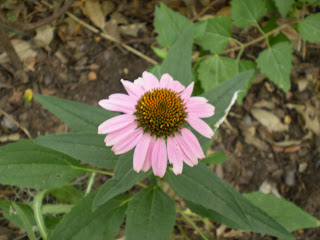 Wow success. A zinnia which is hanging in there but needs constant transfusions of water.
Wow success. A zinnia which is hanging in there but needs constant transfusions of water. And an echinacea, which is doing well in light shade. Austin gardeners know what this means high canopy and survival.
And an echinacea, which is doing well in light shade. Austin gardeners know what this means high canopy and survival. My plumbago has finally started doing it's thing.
My plumbago has finally started doing it's thing. A white ruellia that survived transplanting after the heat started. My kind of plant.
A white ruellia that survived transplanting after the heat started. My kind of plant. But I digress as I so often do. I steer myself firmly back to the garden. It is, as you all must be tired of hearing, unbelievably hot here. Not just hot but DRY, shrivelling dry. It will be a miracle if the majority of plants make it through the summer. My milkweed regularly wilts each day. Somehow I’d envisioned a plant with weed as part of it’s name would be a little tougher. My number one tough plants, excluding cacti, are ruellias. Once they’re established they are tough and very attractive in my opinion. My two artemisias are both doing well, the Powis Castle variety and what I call wormwood. They hardly ever wilt. But this is going to be a test for most of garden. The zinnias are doing their best.
But I digress as I so often do. I steer myself firmly back to the garden. It is, as you all must be tired of hearing, unbelievably hot here. Not just hot but DRY, shrivelling dry. It will be a miracle if the majority of plants make it through the summer. My milkweed regularly wilts each day. Somehow I’d envisioned a plant with weed as part of it’s name would be a little tougher. My number one tough plants, excluding cacti, are ruellias. Once they’re established they are tough and very attractive in my opinion. My two artemisias are both doing well, the Powis Castle variety and what I call wormwood. They hardly ever wilt. But this is going to be a test for most of garden. The zinnias are doing their best.One thing I have decided is that I need to work on my soil depth and quality. I know my soil is fairly shallow. I hadn’t realized how shallow until I had my sewer line replaced a couple of years ago. I have between 8 to 12 inches of soil underlaid by sold limestone. A heroic team jack-hammered down about three or four feet and it was solid the entire way. I think it probably extends many yards down. So not only do I have limited root room what soil I have is underlaid with a porous rock that in a summer drought wicks moisture away from the soil. So I have to bite the bullet and do something about it – next winter. In the meantime I’m gathering supplies. Next fall I’m going to be the number one leaf stealer in my neighborhood. I have two pretty good sized compost heaps in my yard. They are too big for me to turn so I hope time is breaking them down to usable pieces by january. Of course it would help if it rained on them but I don’t hold out much hope.
I have acquired what looks like a lot of limestone bricks left over from a friend’s new house. I’ve been told that once I start to build up the edges of my beds what I’ve got won’t go far, but if I can raise the level of the bed even six inches it will help. I would like to raise it higher but we will see. The part I’m not looking forward to is digging out all the existing plants including bulbs and replanting them. I suppose I can thank the drought for spurring me on to do what I knew had to be done but had successfully put off for several years. I hope this will be the last big project I will have to work on. I supect it won't be but after this the only way I'll embark on large projects is if I move which I refuse to contemplate.
Finally my helper Mirk who encourages me every step of the way.












